-
 Bitcoin
Bitcoin $86,250.6982
1.63% -
 Ethereum
Ethereum $1,890.1026
-0.98% -
 Tether USDt
Tether USDt $1.0000
0.01% -
 XRP
XRP $2.1367
0.29% -
 BNB
BNB $603.5934
-0.76% -
 Solana
Solana $129.4201
2.45% -
 USDC
USDC $1.0000
0.00% -
 Dogecoin
Dogecoin $0.1724
0.45% -
 Cardano
Cardano $0.6839
0.62% -
 TRON
TRON $0.2381
0.57% -
 Toncoin
Toncoin $3.9840
-0.47% -
 Chainlink
Chainlink $13.8431
-2.30% -
 UNUS SED LEO
UNUS SED LEO $9.3956
0.41% -
 Stellar
Stellar $0.2705
-1.46% -
 Avalanche
Avalanche $19.2650
-0.80% -
 Sui
Sui $2.4309
0.03% -
 Shiba Inu
Shiba Inu $0.0...01260
-0.64% -
 Hedera
Hedera $0.1716
0.58% -
 Polkadot
Polkadot $4.1457
-0.42% -
 Litecoin
Litecoin $85.5964
0.72% -
 Bitcoin Cash
Bitcoin Cash $308.6728
-0.07% -
 MANTRA
MANTRA $6.3356
0.99% -
 Bitget Token
Bitget Token $4.5842
-0.52% -
 Dai
Dai $0.9997
-0.04% -
 Ethena USDe
Ethena USDe $0.9999
0.01% -
 Hyperliquid
Hyperliquid $13.7596
4.34% -
 Pi
Pi $0.6794
-3.81% -
 Monero
Monero $219.4683
1.07% -
 Uniswap
Uniswap $6.1878
-0.70% -
 Aptos
Aptos $5.3777
0.02%
How is the sidechain technology of blockchain implemented?
Sidechains, pegged to mainchains like Bitcoin, enable asset transfers, enhancing scalability and functionality while maintaining security through components like two-way pegging and Merkle trees.
Mar 31, 2025 at 04:00 am

Understanding Sidechain Implementation
Sidechains are independent blockchains that are pegged to a mainchain (like Bitcoin or Ethereum). This pegging allows for assets to be transferred between the mainchain and the sidechain, offering benefits like scalability and enhanced functionality without compromising the security of the mainchain. The implementation varies depending on the specific design, but some core components remain consistent.
Key Components of Sidechain Implementation
The successful implementation of a sidechain hinges on several crucial components. These components ensure the secure and efficient transfer of assets and data between the mainchain and the sidechain.
Two-way Pegging: This is the cornerstone of any sidechain. It enables the secure transfer of assets (e.g., Bitcoin) from the mainchain to the sidechain (locking) and back (unlocking). This process usually involves cryptographic proofs to verify the legitimacy of the transfer. The security of the two-way pegging mechanism is paramount as it prevents double-spending and maintains the integrity of both chains.
Merkle Trees: These data structures are used to efficiently verify large amounts of data. In sidechains, Merkle trees are crucial for summarizing transactions on the sidechain, allowing for efficient verification of the sidechain's state by the mainchain. This verification is often necessary for unlocking assets back to the mainchain. The use of Merkle trees significantly improves efficiency in the process of transferring assets.
Federated Consensus or other Consensus Mechanisms: Sidechains often utilize a different consensus mechanism than the mainchain. This might be a federated consensus (where a group of nodes validates transactions) or another suitable algorithm. The choice of consensus mechanism depends on the specific needs and security requirements of the sidechain. For instance, a sidechain focusing on high throughput might opt for a different consensus than a sidechain prioritizing decentralization.
Smart Contracts: Smart contracts can play a significant role in automating the pegging process and managing other aspects of the sidechain. They can be used to define the rules for locking and unlocking assets, enforcing security protocols, and managing the overall functionality of the sidechain. Smart contracts provide automation and programmability, enhancing the flexibility and efficiency of the sidechain.
Security Mechanisms: Robust security is vital. This involves measures to prevent attacks like double-spending, replay attacks, and various other vulnerabilities. These mechanisms are crucial to maintaining the integrity and trustworthiness of the sidechain and protecting user assets.
Step-by-Step Implementation Overview
Implementing a sidechain is a complex process. Here's a simplified overview of the steps involved:
Design and Specification: Define the requirements for the sidechain, including its consensus mechanism, transaction types, and security features.
Development: Develop the sidechain software, including the necessary components like the blockchain engine, consensus algorithm, and pegging mechanisms.
Testing: Thoroughly test the sidechain to identify and fix bugs and vulnerabilities. This is crucial for ensuring the security and reliability of the system.
Deployment: Deploy the sidechain on a network of nodes.
Integration: Integrate the sidechain with the mainchain, enabling the transfer of assets between the two chains.
Auditing: Conduct security audits to identify and address any potential weaknesses.
Different Approaches to Sidechain Implementation
Several approaches exist for implementing sidechains, each with its strengths and weaknesses. These approaches often involve different trade-offs between security, scalability, and decentralization.
Federated Sidechains: These rely on a group of trusted entities (federation) to secure the sidechain. They offer higher throughput but sacrifice some decentralization.
Decentralized Sidechains: These aim for greater decentralization but might face challenges in achieving high throughput.
Plasma Chains: These are a specific type of sidechain that leverage a "child chain" structure for scalability. Plasma chains offer a sophisticated approach to scaling, but they are also more complex to implement.
Addressing Common Questions
Q: What are the advantages of using sidechains?
A: Sidechains offer several advantages, including improved scalability, enabling faster transaction processing and reduced fees. They also allow for experimentation with new features and functionalities without impacting the mainchain.
Q: What are the security risks associated with sidechains?
A: The security of a sidechain depends heavily on its implementation. Risks include vulnerabilities in the consensus mechanism, pegging mechanism, and smart contracts. Attacks targeting the federation in federated sidechains are also a concern.
Q: How do sidechains differ from layer-2 scaling solutions?
A: While both aim to improve scalability, sidechains are separate blockchains pegged to the mainchain, offering more independence. Layer-2 solutions, such as state channels and rollups, operate on top of the mainchain, inheriting its security but with limited independence.
Q: Are all sidechains created equal?
A: No, sidechains vary significantly in their design, security, and functionality. The choice of consensus mechanism, pegging method, and overall architecture greatly influences their performance and security characteristics.
Q: What are some examples of projects using sidechains?
A: Several projects utilize sidechains, including Liquid (Bitcoin sidechain) and various Ethereum-based sidechains that explore different scaling solutions. The specific examples are constantly evolving as the technology matures.
Disclaimer:info@kdj.com
The information provided is not trading advice. kdj.com does not assume any responsibility for any investments made based on the information provided in this article. Cryptocurrencies are highly volatile and it is highly recommended that you invest with caution after thorough research!
If you believe that the content used on this website infringes your copyright, please contact us immediately (info@kdj.com) and we will delete it promptly.
- Grayscale Launches Two New Bitcoin ETFs: BTCC and BPI
- 2025-04-03 02:05:12
- Bitcoin (BTCUSD) Has Been on an Upward Trajectory Despite Volatility in Crypto and Traditional Markets
- 2025-04-03 02:05:12
- Ripple Integrates Its USD-Backed Stablecoin to Cross-Border Payments System
- 2025-04-03 02:00:12
- Dogecoin (DOGE) Forms Inverse H&S Pattern, Presenting Immediate Breakout Targets
- 2025-04-03 02:00:12
- Retesting the 61.8% Fibonacci Retracement Level Could Be a Defining Moment for the SOL/USD Pair
- 2025-04-03 01:55:13
- Ozak AI (OZ) Could Be the Next 1000x Gainer, Not Gold
- 2025-04-03 01:55:13
Related knowledge
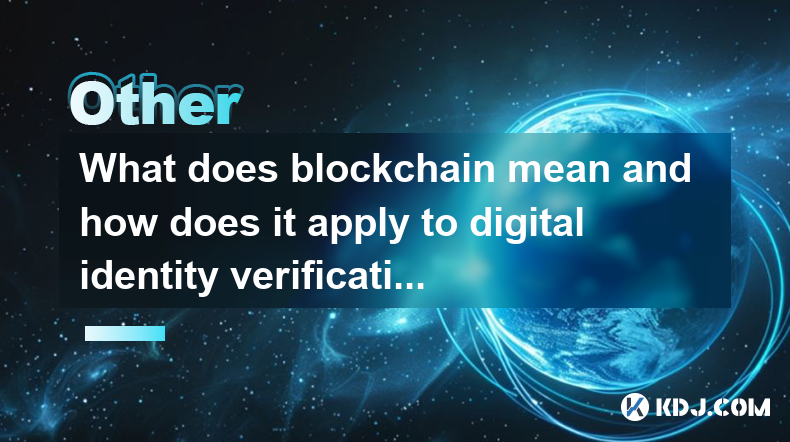
What does blockchain mean and how does it apply to digital identity verification?
Apr 03,2025 at 02:21am
Blockchain technology, at its core, is a decentralized and distributed digital ledger used to record transactions across numerous computers. This ensures that the recorded data cannot be altered retroactively without the alteration of all subsequent blocks and the consensus of the network. The concept of blockchain was initially devised for the digital ...
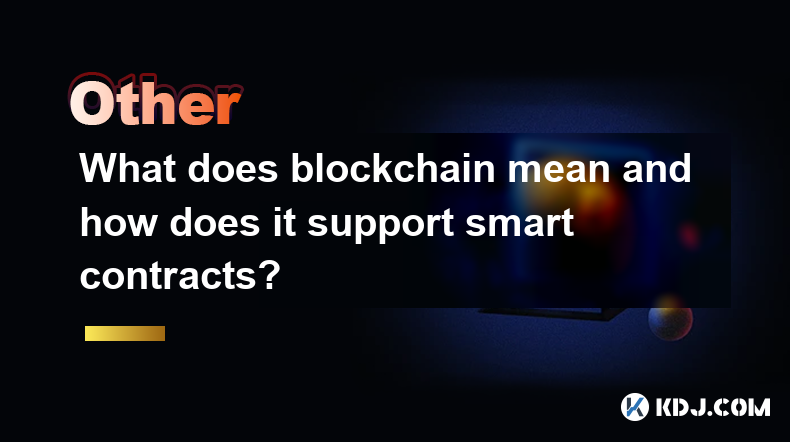
What does blockchain mean and how does it support smart contracts?
Apr 03,2025 at 02:28am
Blockchain technology is a decentralized, distributed ledger that records transactions across numerous computers. It ensures that once data is recorded, it cannot be altered retroactively without the alteration of all subsequent blocks and the consensus of the network. This technology is the backbone of cryptocurrencies like Bitcoin and Ethereum. Blockc...
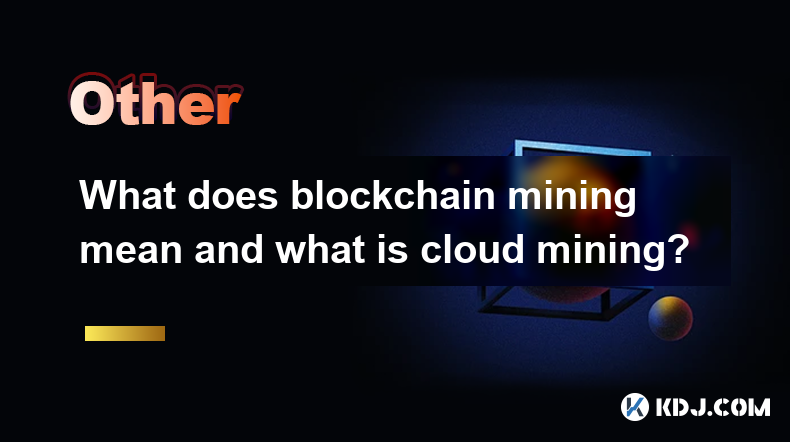
What does blockchain mining mean and what is cloud mining?
Apr 03,2025 at 02:01am
Blockchain mining is the process by which new transactions are verified and added to the blockchain ledger. It involves solving complex mathematical problems using computational power, which results in the creation of new cryptocurrency units as a reward. Miners compete to solve these problems, and the first one to find the solution gets to add a new bl...
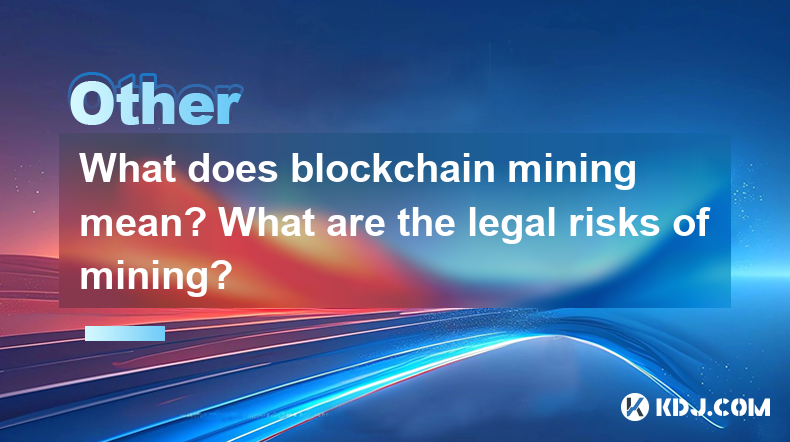
What does blockchain mining mean? What are the legal risks of mining?
Mar 31,2025 at 05:07pm
Blockchain mining is the process by which transactions are verified and added to the public ledger, known as the blockchain. Miners use powerful computers to solve complex mathematical problems, which, once solved, allow them to add a block of transactions to the blockchain. In return, miners are rewarded with cryptocurrency, typically Bitcoin. This pro...
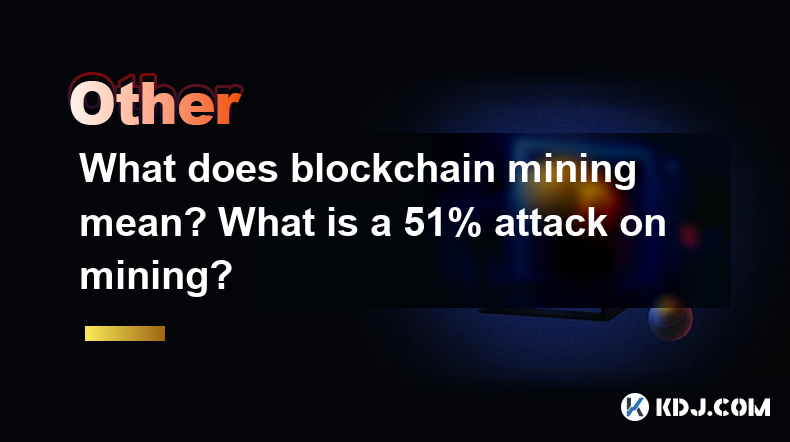
What does blockchain mining mean? What is a 51% attack on mining?
Apr 02,2025 at 03:28am
Blockchain mining is a critical process in the world of cryptocurrencies, particularly those that use proof-of-work (PoW) consensus mechanisms like Bitcoin. Mining involves using computational power to solve complex mathematical puzzles, which, when solved, validate and add new transactions to the blockchain. Miners are incentivized to participate throu...

What does blockchain mining mean? What is liquidity mining?
Apr 01,2025 at 12:07am
What is Blockchain Mining?Blockchain mining is a critical process in the world of cryptocurrencies, particularly for networks like Bitcoin and Ethereum. It involves the use of computational power to solve complex mathematical problems, which in turn validates transactions and adds them to the blockchain. Miners are incentivized through rewards, typicall...

What does blockchain mean and how does it apply to digital identity verification?
Apr 03,2025 at 02:21am
Blockchain technology, at its core, is a decentralized and distributed digital ledger used to record transactions across numerous computers. This ensures that the recorded data cannot be altered retroactively without the alteration of all subsequent blocks and the consensus of the network. The concept of blockchain was initially devised for the digital ...

What does blockchain mean and how does it support smart contracts?
Apr 03,2025 at 02:28am
Blockchain technology is a decentralized, distributed ledger that records transactions across numerous computers. It ensures that once data is recorded, it cannot be altered retroactively without the alteration of all subsequent blocks and the consensus of the network. This technology is the backbone of cryptocurrencies like Bitcoin and Ethereum. Blockc...

What does blockchain mining mean and what is cloud mining?
Apr 03,2025 at 02:01am
Blockchain mining is the process by which new transactions are verified and added to the blockchain ledger. It involves solving complex mathematical problems using computational power, which results in the creation of new cryptocurrency units as a reward. Miners compete to solve these problems, and the first one to find the solution gets to add a new bl...

What does blockchain mining mean? What are the legal risks of mining?
Mar 31,2025 at 05:07pm
Blockchain mining is the process by which transactions are verified and added to the public ledger, known as the blockchain. Miners use powerful computers to solve complex mathematical problems, which, once solved, allow them to add a block of transactions to the blockchain. In return, miners are rewarded with cryptocurrency, typically Bitcoin. This pro...

What does blockchain mining mean? What is a 51% attack on mining?
Apr 02,2025 at 03:28am
Blockchain mining is a critical process in the world of cryptocurrencies, particularly those that use proof-of-work (PoW) consensus mechanisms like Bitcoin. Mining involves using computational power to solve complex mathematical puzzles, which, when solved, validate and add new transactions to the blockchain. Miners are incentivized to participate throu...

What does blockchain mining mean? What is liquidity mining?
Apr 01,2025 at 12:07am
What is Blockchain Mining?Blockchain mining is a critical process in the world of cryptocurrencies, particularly for networks like Bitcoin and Ethereum. It involves the use of computational power to solve complex mathematical problems, which in turn validates transactions and adds them to the blockchain. Miners are incentivized through rewards, typicall...
See all articles
























































































